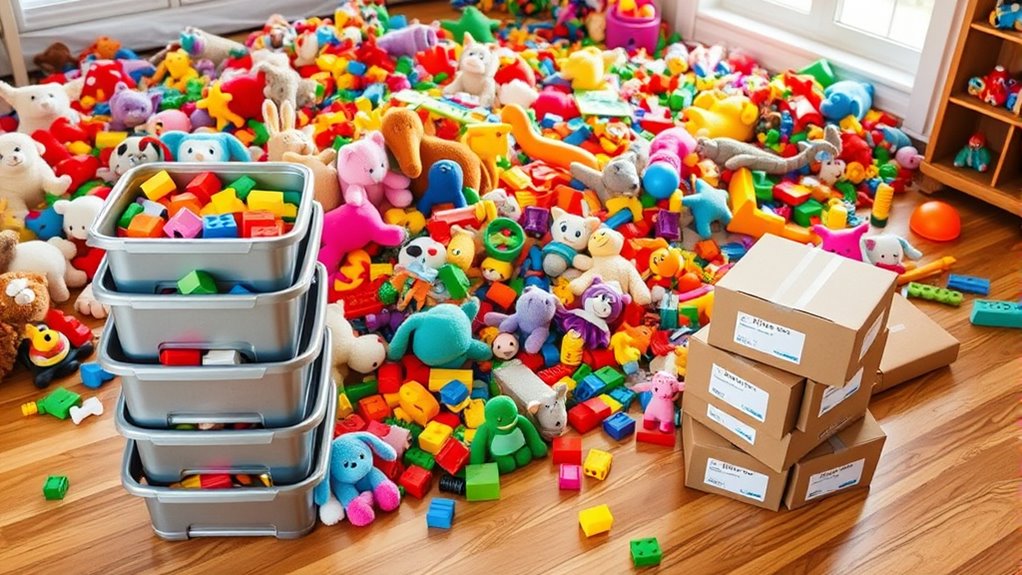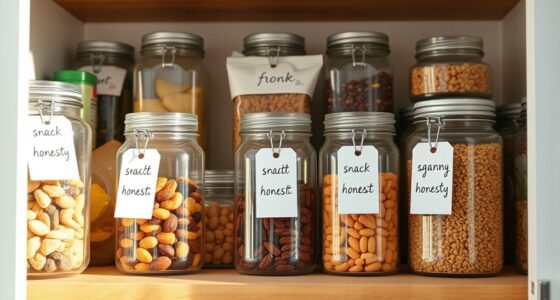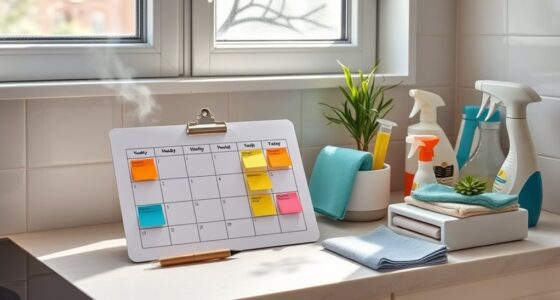To manage toy clutter, start by gathering all toys and sorting through them. Decide what your child truly uses and loves, then set aside those to keep and store. Donate toys they’ve outgrown or no longer play with in a donation box. Use clear bins and labels to organize the kept toys, making cleanup easier. By following these steps, you’ll create a tidy, safe space—keep exploring for more tips to streamline the process.
Key Takeaways
- Assess all toys to determine which are actively used and loved, setting aside those for donation or disposal.
- Categorize toys into groups and store them in accessible, labeled containers for easy organization and cleanup.
- Regularly review toy collections to identify excess items and donate or discard unused or outgrown toys.
- Use designated storage solutions like bins and shelves to keep toys organized and prevent clutter buildup.
- Encourage children to put toys back in their designated spots and schedule routine decluttering sessions.

Ever feel overwhelmed by the endless pile of toys scattered across your home? It’s a common struggle, but the good news is that you can regain control with effective toy clutter triage. The key lies in making deliberate decisions about what to keep, what to store, and what to donate. Start by tackling the chaos head-on, and you’ll find that a well-organized space becomes achievable. To do this successfully, you’ll need to focus on practical storage solutions and clutter organization techniques that make maintaining order easier.
First, gather all the toys in one place. Seeing everything together helps you assess what your child genuinely plays with and what’s just taking up space. As you sort through, think about creating designated storage solutions that suit your home’s layout and your child’s habits. Use bins, baskets, and shelves to categorize toys—perhaps one for action figures, another for building blocks, and a separate one for art supplies. Clear containers are especially helpful because they allow you to see everything at a glance, reducing the chances of toys getting buried in the back and forgotten. Labeling each container can further streamline clutter organization, making it easier for your child to put toys back in their designated spots.
As you go through this process, be honest about which toys are truly used and loved. Keep the favorites accessible and within reach, but set aside items that no longer get played with. For those, consider a donation box. Donating toys not only declutters your space but also brings joy to other children who might not have many toys of their own. Making sure to dispose of unused toys properly can help keep your home tidy and safe. Make it a routine to review and donate toys periodically, preventing clutter from building up again.
Frequently Asked Questions
How Often Should I Reassess My Child’s Toy Collection?
You should reassess your child’s toy collection every three to six months. Regular toy rotation helps prevent clutter and keeps playtime fresh. During these checks, evaluate which toys are still enjoyed and which can be donated or stored away. This routine not only reduces clutter but also encourages your child to appreciate their toys more. Consistent reassessment makes clutter prevention easier and keeps your child’s play area organized and inviting.
What Are Eco-Friendly Donation Options for Toys?
When it comes to eco-friendly toy donations, you’re hitting two birds with one stone. Look for charities that prioritize sustainable donation practices or eco-conscious toy recycling. Many organizations accept gently used toys and confirm they’re reused or repurposed responsibly, reducing waste. Consider local shelters, community centers, or eco-conscious nonprofits. This way, your donations support a greener planet while giving toys a second life, making your efforts truly worthwhile.
How Do I Handle Sentimental Attachment to Certain Toys?
When handling sentimental attachment to certain toys, acknowledge your emotional connection and take time to reflect on why those toys matter. You might take photos of them to preserve memories without keeping the physical item. If you’re struggling, consider keeping just a few special pieces and letting go of the rest. This approach helps honor the sentimental value while reducing clutter, making it easier to move forward emotionally.
What Safety Considerations Should I Keep in Mind During Decluttering?
When decluttering, prioritize safety by inspecting toys for small parts that pose choking hazards and sharp edges that could cause injuries. Use toy storage solutions like bins or shelves to keep toys organized and off the floor, reducing tripping hazards. Always supervise children during play, and dispose of damaged or unsafe toys promptly. Keeping safety in mind helps create a clutter-free, secure environment for everyone.
How Can I Involve Children in the Toy Triage Process?
Getting kids involved makes decluttering easier and more enjoyable. You can encourage child participation by assigning age-appropriate tasks, like sorting toys by type or size. Make it fun and friendly, focusing on their participation rather than perfection. Use positive praise to promote pride in their decisions. This approach helps children learn about organization, responsibility, and the importance of keeping their space tidy, all while making the process playful and productive.
Conclusion
By sorting your toys into keep, store, or donate piles, you create a more organized space and teach your kids valuable lessons about clutter management. Interestingly, research shows that decluttering can reduce stress and boost overall well-being. So, as you triage, remember that less truly can be more—fewer toys mean more meaningful play and less chaos. Embrace this process, and you’ll find a calmer, happier home where both you and your children thrive.









